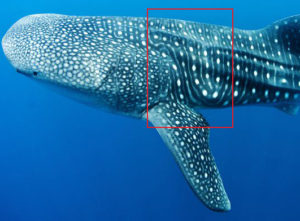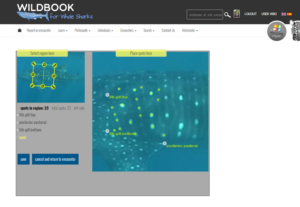Just like a human fingerprint, whale sharks have their own unique patterns. Scientists can use these distinctive spots and stripes to identify individuals and track their growth, movements and migrations across the planet. Photo identification is a common practise amongst many animal research projects. Species include humpback whales, manta rays, turtles, seals, cheetahs, lizards, giraffes and many more. The software that most of these photo ID projects use, including whale sharks, was originally created by NASA for identifying star systems. Therefore it’s quite fitting that the Madagascan name for whale sharks, ‘marokintana’, translates to ‘many stars’ and the Japanese, ‘geger lintang’, means ‘stars in the back’.
Scientists and citizen scientists involved in monitoring whale shark populations take photographs of individuals to make estimates of abundance as well as study population dynamics, migrations and site fidelity. The red box in the photo below (Fig. 1) shows the universal photo ID area. It is always the left hand side of the shark (to act as a global control variable) and must show the top and bottom of the last (5th) gill slit and where the pectoral fin meets the body. After the ID photo, it is customary to look under the shark to check the sex of the animal and also take note of any injuries. It’s very important for the information on each shark to be regularly updated. If a shark has previously been seen without any injuries then we can make assumptions about when, where and how the new injuries occurred.
Figure 1. The universal photo identification area of the whale shark (Rhincodon typus)
Once useable ID photos have been obtained, each shark encounter can be loaded into its own photo identification library and then into the global database programme ‘Wildbook for Whale Sharks’. This database, which currently has over 8100 confirmed whale shark individuals, was created by software programmer Jason Holmberg in 2003 after a rare encounter with a whale sharks whilst scuba diving in the Red Sea. This inspired him to create and improve methods for tracking these gentle giants. Originally Holmberg, with the help of Australian-based non-profit ECOCEAN, marine biologist Brad Norman examined and compared photos of whale sharks by eye, but found this to be a long and tedious process. So with the help of Goddard Space Flight Center astrophysicist Zaven Arzoumanian, they discovered the solution was the Groth algorithm.
In 1986, with the support of the Hubble Space Telescope programme, Edward J. Groth, a Princeton University physics professor, invented a pattern-matching algorithm intended to address the challenge of mapping the dauntingly vast star fields. The NASA website, 2012, explains the magnitude of star system mapping by inviting you to type a lower-case ‘o’ in Times New Roman, 10-point font and printing the paper. Then hold it at arm’s length. From this distance the area inside the ‘o’ is approximately equal to the area observed in the Hubble Ultra Deep Field, which is an image taken by the Hubble Space Telescope. Within that tiny space, Hubble revealed around 10,000 galaxies, each containing billions of stars.
Whilst the spots on a whale shark are at the most in the hundreds, Holmberg and Arzoumanian could modify the same Groths algorithm to match the unique patterns (Fig. 2). Thanks to their work, marine biologists and citizen scientists now only have to look through the potential matched photos on the database that have similar patterns. If a match is found, the new photo gets included into the database for each individual shark. If not, a new shark database is created for that individual. Entering our photo identification data is an important part of Whale Shark Diaries’ research and monitoring. Without programs like Wildbook, it would impossible to obtain this sort of information that is vital to the conservation of the endangered whale shark.
Figure 2. The photo identification process (spot selection) in the universal ID area on Wildbook for Whale Sharks.
For more information about us click here.
Wildbook for Whale Sharks click here.
For more information on NASA’s Algorithm click here.
Like and Share Our Facebook Page and Follow Us on Instagram
Facebook Page [scroll down for Instagram]


